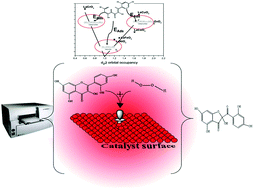Effect of dz2 orbital electron-distribution of La-based inorganic perovskites on surface kinetics of a model reaction†
Abstract
Lanthanum-based perovskites, LaMO3 (M = Co, Fe, Mn, Ni, Cr, Cu, Zn) were synthesized using sol–gel method and characterised using both physical and chemical techniques. Despite the prominence of inorganic perovskites in catalysis, catalyst-specific descriptors that enable design of reaction- or substrate-specific catalysts are not clearly defined. In this work, we put more emphasis on HOMO electron distributions in the degenerate eg orbital of first row transition metals in the B-site of La-based inorganic perovskites. Herein, preliminary findings obtained using density functional theory calculations indicate that the oxidation of morin is dependent on the occupation of the dz2 orbital rather than the entire eg orbital. Regions of low and high dz2 orbital occupation result in high catalytic activity compared to half-filled occupation. Furthermore, the LaCrO3 perovskite with a lowest surface area, 2.7 m2 g−1 gave the highest activity, 7.16 × 10−2 s−1 suggesting that the surface area cannot be used as the sole descriptor for catalytic activity.

- This article is part of the themed collection: Recent Open Access Articles in Frontiers Journals


 Please wait while we load your content...
Please wait while we load your content...